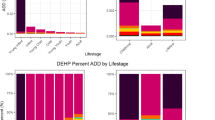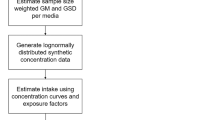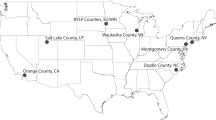Abstract
This paper identifies and ranks food items by estimating their contribution to the dietary exposure of the US population and 19 subpopulation groups. Contributions to dietary exposures to arsenic, cadmium, chromium, lead, nickel, benzene, chlorpyrifos, and diazinon are estimated using either the Dietary Exposure Potential Model (DEPM) approach, the National Human Exposure Assessment Survey Arizona (NHEXAS-AZ) approach or the combination of the two. The DEPM is a computer model that uses several national databases of food consumption and residue concentrations for estimating dietary. The DEPM approach ranks the contribution of food items to the total dietary exposure using two methods, the direct method that ranks contributions by population exposure magnitude and the weighted method that ranks by subpopulation exposure magnitude. The DEPM approach identifies highly exposed subpopulations and a relatively small number of food items contributing the most to dietary exposure. The NHEXAS-AZ approach uses the NHEXAS-AZ database containing food consumption data for each subject and chemical residues of a composite of food items consumed by each subject in 1 day during the sampling week. These data are then modeled to obtain estimates of dietary exposure to chemical residues. The third approach uses the NHEXAS-AZ consumption data with residue values from the national residue database. This approach also estimates percent contributions to exposure of each ranked food item for the Arizona population. Dietary exposures estimated using the three approaches are compared. The DEPM results indicate groups with highest dietary exposures include Nonnursing Infants, Children 1–6, Hispanic, Non-Hispanic White, Western, Northeast and Poverty 0–130%. The use of the Combined National Residue Database (CNRD) identifies 43 food items as primary contributors to total dietary exposure; they contribute a minimum of 68% of the total dietary exposure to each of the eight chemical residues. The percent contribution of ranked food items estimated using the NHEXAS samples is smaller than those obtained from the western US population via the DEPM. This indicates differences in consumption characteristics of the two groups with respect to the ranked food items. Six of 15 food items consumed by the NHEXAS-AZ subjects per day are ranked food items contributing between 56% and 70% of the estimated NHEXAS-AZ dietary exposure to each of the eight chemical residues. The difference between total dietary exposure estimates from the DEPM and NHEXAS-AZ approaches varies by chemical residue and is attributable to differences in sampling and analytical methods, and geographic areas represented by the data. Most metal exposures estimated using the NHEXAS consumption data with the CNRD have lower values than those estimated via the other approaches, possibly because the NHEXAS-AZ residue values are higher than the CNRD values. In addition, exposure estimates are seemingly affected by the difference in demographic characteristics and factors that affect types and amounts of food consumed. Efficient control strategies for reducing dietary exposure to chemical residues may be designed by focusing on the relatively small number of food items having similar ingredients that contribute substantively to the total ingestion exposure.
This is a preview of subscription content, access via your institution
Access options
Subscribe to this journal
Receive 6 print issues and online access
$259.00 per year
only $43.17 per issue
Buy this article
- Purchase on Springer Link
- Instant access to full article PDF
Prices may be subject to local taxes which are calculated during checkout
Similar content being viewed by others
Abbreviations
- NHEXAS:
-
National Human Exposure Assessment Survey
- DEPM:
-
Dietary Exposure Potential Model
- CSFII:
-
Continuing Survey of Food Intake by Individual
- CNRD:
-
Combined National Residue Database
- TDS:
-
Total Diet Study
- FDA:
-
Food and Drug Administration
- USDA:
-
US Department of Agriculture
- ECF:
-
exposure core food
References
Berry MR Strategy for a dietary exposure research program, J Expos Anal Environ Epidemiol (1992) Suppl. 1: 97–110
Berry MR Tomerlin JR A Dietary Exposure Potential Model using extant databases to estimate exposure to chemical residues In Proceedings of the EPA/AWMA International Specialty Conference, “Measurement of Toxic and Related, Air Pollutants (VIP-64)”. Air and Waste Management Association, Pittsburgh, PA, 1996 pp 819–828
Dietary Exposure Potential Model (DEPM) Version 3.3.2A software available for evaluation on the internet at http://www.epa.gov/nerlcwww/depm.htm2000
Helsel DR Less than obvious: statistical treatment of data below the detection limit, Environ Sci Technol (1990) 24(12): 1766–1774
Lebowitz MD O'Rourke MK Gordon S Moschandreas DJ Buckley T Nishioka M Population-based exposure measurements in Arizona: a phase I field study in support of the national human exposure assessment survey, J Expos Anal Environ Epidemiol (1995) 5(3): 297–325
Melnyk LJ Berry MR Sheldon LS Freeman NCG Pellizzari ED Kinman RN Dietary exposure of children living in lead-laden environments, J Expos Anal Environ Epidemiol (2000) 10 6; Part 2 723–731
Mohri T Hisanaga A Ishinishi N Arsenic intake and excretion by Japanese adults: a 7-day duplicate diet study, Food Chem Toxicol (1990) 28(7): 521–529
Pennington JAT Gunderson EL History of the food and drug administration's Total Diet Study — 1961 to 1987, J Assoc Off Anal Chem Int (1987) 70: 772–782
Reilly C Metal Contamination of Food 2nd edElsevier, New York, NY, USA 1991
Tomerlin JR Berry MR Tran NL Chew S-B Petersen BJ Tucker KD Fleming KH Development of a Dietary Exposure Potential Model for evaluating dietary exposure to chemical residue in food, J Expos Anal Environ Epidemiol (1993) 7 No. 1 82–102
US Department of Health and Human Service Public Health Service, Agency for Toxic Substances and Disease Registry, Toxicological Profile for Arsenic (1993a)
US Department of Health and Human Service Public Health Service, Agency for Toxic Substances and Disease Registry, Toxicological Profile for Cadmium (1993b)
US Department of Health and Human Service Public Health Service, Agency for Toxic Substances and Disease Registry, Toxicological Profile for Chromium (1993c)
US Department of Health and Human Service Public Health Service, Agency for Toxic Substances and Disease Registry, Toxicological Profile for Lead (1993d)
US Department of Health and Human Service Public Health Service, Agency for Toxic Substances and Disease Registry, Toxicological Profile for Nickel (1995)
US Department of Health and Human Service Public Health Service, Agency for Toxic Substances and Disease Registry, Toxicological Profile for Benzene (1997)
World Health Organization (WHO). Environmental Health Criteria 150, Benzene (1993)
World Health Organization (WHO) Environmental Health Criteria 198, Diazinon (1998)
Author information
Authors and Affiliations
Corresponding author
Additional information
Although this work was funded by the US Environmental Protection Agency (Coop agreement no. CR821560-01-0), it does not necessarily reflect the views of the agency and no official endorsement should be inferred.
Rights and permissions
About this article
Cite this article
MOSCHANDREAS, D., KARUCHIT, S., BERRY, M. et al. Exposure apportionment: Ranking food items by their contribution to dietary exposure. J Expo Sci Environ Epidemiol 12, 233–243 (2002). https://doi.org/10.1038/sj.jea.7500230
Received:
Published:
Issue Date:
DOI: https://doi.org/10.1038/sj.jea.7500230
Keywords
This article is cited by
-
Association between dietary cadmium intake and early gastric cancer risk in a Korean population: a case–control study
European Journal of Nutrition (2019)
-
Arsenic Exposure in Children through Drinking Water in Different Districts of Sindh, Pakistan
Biological Trace Element Research (2016)
-
Toxic Risk Assessment of Arsenic in Males Through Drinking Water in Tharparkar Region of Sindh, Pakistan
Biological Trace Element Research (2016)
-
Contribution of diet to aggregate arsenic exposures—An analysis across populations
Journal of Exposure Science & Environmental Epidemiology (2014)
-
Measured versus modeled dietary arsenic and relation to urinary arsenic excretion and total exposure
Journal of Exposure Science & Environmental Epidemiology (2013)



